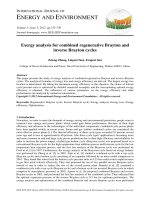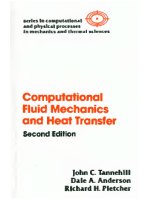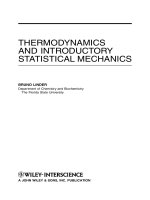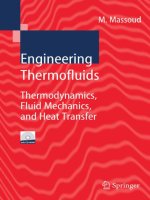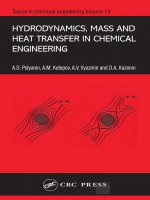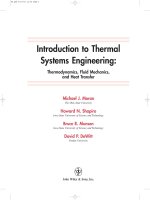Thermodynamics and heat powered cycles (malestrom)
Bạn đang xem bản rút gọn của tài liệu. Xem và tải ngay bản đầy đủ của tài liệu tại đây (10.26 MB, 677 trang )
THERMODYNAMICS AND HEAT
POWERED CYCLES:
A COGNITIVE
E
NGINEERING APPROACH
THERMODYNAMICS AND HEAT
POWERED CYCLES:
A
COGNITIVE
ENGINEERING APPROACH
CHIH WU
Nova Science Publishers, Inc.
New York
Copyright © 2007 by Nova Science Publishers, Inc.
All rights reserved. No part of this book may be reproduced, stored in a retrieval system or
transmitted in any form or by any means: electronic, electrostatic, magnetic, tape, mechanical
photocopying, recording or otherwise without the written permission of the Publisher.
For permission to use material from this book please contact us:
Telephone 631-231-7269; Fax 631-231-8175
Web Site:
NOTICE TO THE READER
The Publisher has taken reasonable care in the preparation of this book, but makes no expressed or
implied warranty of any kind and assumes no responsibility for any errors or omissions. No
liability is assumed for incidental or consequential damages in connection with or arising out of
information contained in this book. The Publisher shall not be liable for any special,
consequential, or exemplary damages resulting, in whole or in part, from the readers’ use of, or
reliance upon, this material.
Independent verification should be sought for any data, advice or recommendations contained in
this book. In addition, no responsibility is assumed by the publisher for any injury and/or damage
to persons or property arising from any methods, products, instructions, ideas or otherwise
contained in this publication.
This publication is designed to provide accurate and authoritative information with regard to the
subject matter covered herein. It is sold with the clear understanding that the Publisher is not
engaged in rendering legal or any other professional services. If legal or any other expert
assistance is required, the services of a competent person should be sought. FROM A
DECLARATION OF PARTICIPANTS JOINTLY ADOPTED BY A COMMITTEE OF THE
AMERICAN BAR ASSOCIATION AND A COMMITTEE OF PUBLISHERS.
L
IBRARY OF CONGRESS CATALOGING-IN-PUBLICATION DATA
Wu, Chih, 1936-
Thermodynamics and heat powered cycles : a cognitive engineering approach / Chih Wu.
p. cm.
Includes bibliographical references and index.
ISBN-13:
978-1-60692-626-0
1. Thermodynamics Data processing. I. Title.
TJ265.W827 2006
621.402'1 dc22 2006004477
Published by Nova Science Publishers, Inc.
New York
TO MY WIFE, HOYING TSAI WU
AND TO MY CHILDREN, ANNA, JOY, SHEREE AND PATRICIA
CONTENTS
Preface xiii
Acknowledgements xv
Chapter 1 Basic Concepts 1
1.1. Thermodynamics 1
1.2. Basic Laws 2
1.3. Why Study Thermodynamics? 3
1.4. Dimensions and Units 5
1.5. Systems 10
1.6. Properties of a System 12
1.7. Equilibrium State 23
1.8. Processes and Cycles 24
1.9. CyclePad 26
1.10. Summary 29
Chapter 2 Properties of Thermodynamic Substances 31
2.1. Thermodynamic Substances 31
2.2. Pure Substances 31
2.3. Ideal gases 54
2.4. Real gases 63
2.5. Incompressible Substances 65
2.6. Summary 69
Chapter 3 First Law of Thermodynamics for Closed Systems 71
3.1. Introduction 71
3.2. Work 71
3.3. Heat 78
3.4. First Law of Thermodynamics for a Closed System 80
3.5. First Law of Thermodynamics for a Closed System Apply
to Cycles 84
3.6. Closed System for Various Processes 86
3.7. Multi- Process 104
3.8. Summary 108
Contents viii
Chapter 4 First Law of Thermodynamics for Open Systems 109
4.1. Introduction 109
4.2. Conservation of Mass 109
4.3. First Law of Thermodynamics 112
4.4. CyclePad Open System Devices 115
4.5. Other Devices (Unable toUse CyclePad) 150
4.6. Systems Consisting of More than One Open-System
Device 152
4.7. Summary 156
Chapter 5 Second Law of Thermodynamics 157
5.1. Introduction 157
5.2. Definitions 157
5.3. Second Law Statements 167
5.4. Reversible and Irreversible Processes 168
5.5. Carnot Cycle 168
5.6. Carnot Corollaries 176
5.7. The Thermodynamic Temperature Scale 177
5.8. Summary 177
Chapter 6 Entropy 179
6.1. Clausius Inequality 179
6.2. Entropy and Heat 180
6.3. Heat and Work as Areas 183
6.4. Entropy and Carnot Cycles 183
6.5. Second Law of Thermodynamics for Closed Systems 185
6.6. Second Law of Thermodynamics for Open Systems 187
6.7. Property Relationships 188
6.8. Isentropic Processes 196
6.9. Isentropic Efficiency 199
6.10. Entropy Change of Irreversible Processes 210
6.11. The Increase of Entropy Principle 213
6.12. Second Law Efficiency and Effectiveness of Cycles 215
6.13. Available and Unavailable Energy 225
6.14. Summary 226
Chapter 7 Exergy and Irreversibility 227
7.1. Introduction 227
7.2. Reversible and Irreversible Work 227
7.3. Reversible Work of a Closed System 231
7.4. Reversible Work of an Open System 234
7.5. Reversible Work of an Open System in a Steady-State
Flow Process 235
7.6. Irreversibility of a Closed System 238
7.7. Irreversibility of an Open System 240
7.8. Exergy (Availability) 244
7.9. Exergy of a Heat Reservoir 245
Contents ix
7.10. Exergy and Exergy Change of a Closed System 248
7.11. Exergy of a Flow Stream and Flow Exergy Change of an
Open System 253
7.12. The Decrease of Exergy Principle 257
7.13. Exergy effectiveness of devices 259
7.14. Exergy Cycle Efficiency 261
7.15. Summary 266
Chapter 8 Vapor Cycles 269
8.1. Carnot Vapor Cycle 269
8.2. Basic Rankine Vapor Cycle 272
8.3. Improvements to Rankine Cycle 281
8.4. Actual Rankine Cycle 282
8.5. Reheat Rankine Cycle 289
8.6. Regenerative Rankine Cycle 295
8.7. Low-temperature Rankine Cycles 307
8.8. Solar Heat Engines 308
8.9. Geothermal Heat Engines 312
8.10. Ocean Thermal Energy Conversion 323
8.11. Solar Pond Heat Engines 328
8.12. Waste Heat Engines 330
8.13. Vapor Cycle Working Fluids 332
8.14. Kalina Cycle 333
8.15. Non-Azeotropic Mixture Rankine Cycle 334
8.16. Super-Critical Cycle 336
8.17. Design Examples 338
8.18 Summary 353
Chapter 9 Gas Closed System Cycles 355
9.1. Otto Cycle 355
9.1A. Wankel Engine 368
9.2. Diesel Cycle 369
9.3. Atkinson Cycle 381
9.4. Dual Cycle 383
9.5. Lenoir Cycle 388
9.6. Stirling Cycle 391
9.7. Miller Cycle 396
9.8. Wicks Cycle 401
9.9. Rallis Cycle 403
9.10. Design Examples 409
9.11 Summary 423
Chapter 10 Gas Open System Cycles 425
10.1. Brayton or Joule Cycle 425
10.2. Split-Shaft Gas Turbine Cycle 435
10.3. Improvements to Brayton Cycle 438
10.4. Reheat and Inter-Cool Brayton Cycle 439
Contents x
10.5. Regenerative Brayton Cycle 444
10.6. Bleed Air Brayton Cycle 448
10.7. Feher Cycle 455
10.8. Ericsson Cycle 459
10.9. Braysson Cycle 463
10.10. Steam Injection Gas Turbine Cycle 467
10.11. Field Cycle 468
10.12. Wicks Cycle 471
10.13. Ice Cycle 473
10.14. Design Examples 475
10.15. Summary 479
Chapter 11 Combined Cycle and Co-Generation 481
11.1. Combined Cycle 481
11.2. Triple Cycle in Series 489
11.3. Triple Cycle in Parallel 494
11.4. Cascaded Cycle 497
11.5. Brayton/Rankine Combined Cycle 499
11.6. Brayton/Brayton Combined Cycle 503
11.7. Rankine/Rankine Combined Cycle 508
11.8. Field Cycle 511
11.9. Co-Generation 514
11.10. Design Examples 523
11.11. Summary 528
Chapter 12 Refrigeration and Heat Pump Cycles 529
12.1. Carnot Refrigerator and Heat Pump 529
12.2. Basic Vapor Refrigeration Cycle 532
12.3. Actual Vapor Refrigeration Cycle 537
12.4. Basic Vapor Heat Pump Cycle 540
12.5. Actual Vapor Heat Pump Cycle 544
12.6. Working Fluids for Vapor Refrigeration and Heat Pump
Systems 546
12.7. Cascade and Multi-Staged Vapor Refrigerators 547
12.8. Domestic Refrigerator-Freezer System, and Air
Conditioning-Heat Pump System 555
12.9. Absorption Air-Conditioning 560
12.10. Brayton Gas Refrigeration Cycle 561
12.11. Stirling Refrigeration Cycle 567
12.12. Ericsson Cycle 570
12.13. Liquefaction of Gases 572
12.14. Non-Azeotropic Mixture Refrigeration Cycle 573
12.15. Design Examples 576
12.16. Summary 584
Chapter 13 Finite-Time Thermodynamics 587
13.1. Introduction 587
Contents xi
13.2. Rate of Heat Transfer 588
13.3. Heat Exchanger 590
13.4. Curzon and Ahlborn (Endoreversible Carnot) Cycle 596
13.5. Curzon and Ahlborn Cycle with
Finite Heat Capacity Heat Source and Sink 605
13.6. Finite Time Rankine Cycle with
Infinitely Large Heat Reservoirs 609
13.7. Actual Rankine Cycle with
Infinitely Large Heat Reservoirs 613
13.8. Ideal Rankine Cycle with Finite Capacity Heat Reservoirs 616
13.9. Actual Rankine Cycle with Finite Capacity Heat
Reservoirs 626
13.10. Finite Time Brayton Cycle 633
13.11. Actual Brayton Finite Time Cycle 640
13.12. Other Finite Time Cycles 643
13.13. Summary 649
References 651
Index 653
PREFACE
Due to the rapid advances in computer technology, intelligent computer software and
multimedia have become essential parts of engineering education. Software integration with
various media such as graphics, sound, video and animation is providing efficient tools for
teaching and learning. A modern textbook should contain both the basic theory and
principles, along with an updated pedagogy.
Often traditional engineering thermodynamics courses are devoted only to analysis, with
the expectation that students will be introduced later to relevant design considerations and
concepts. Cycle analysis is logically and traditionally the focus of applied thermodynamics.
Type and quantity are constrained, however, by the computational efforts required. The
ability for students to approach realistic complexity is limited. Even analyses based upon
grossly simplified cycle models can be computationally taxing, with limited educational
benefits. Computerized look-up tables reduce computational labor somewhat, but modeling
cycles with many interactive loops can lie well outside the limits of student and faculty time
budgets.
The need for more design content in thermodynamics books is well documented by
industry and educational oversight bodies such as ABET (Accreditation Board for
Engineering and Technology). Today, thermodynamic systems and cycles are fertile ground
for engineering design. For example, niches exist for innovative power generation systems
due to deregulation, co-generation, unstable fuel costs and concern for global warming.
Professor Kenneth Forbus of the computer science and education department at
Northwestern University has developed ideal intelligent computer software for
thermodynamic students called CyclePad
*
. CyclePad is a cognitive engineering software. It
creates a virtual laboratory where students can efficiently learn the concepts of
thermodynamics, and allows systems to be analyzed and designed in a simulated, interactive
computer aided design environment. The software guides students through a design process
and is able to provide explanations for results and to coach students in improving designs.
Like a professor or senior engineer, CyclePad knows the laws of thermodynamics and how to
apply them. If the user makes an error in design, the program is able to remind the user of
essential principles or design steps that may have been overlooked. If more help is needed,
the program can provide a documented, case study that recounts how engineers have resolved
*
CyclePad is freely distributed to the public. In just a few steps, anyone with access to a web browser can download
the latest edition over the web. The necessary URL is: www.qrg.ils.northwestern.edu. Computer literate users
with an exposure to thermodynamics will require little or no help in order to effectively use the software.
Chih Wu xiv
similar problems in real life situations. CyclePad eliminates the tedium of learning to apply
thermodynamics, and relates what the user sees on the computer screen to the design of actual
systems.
This integrated, engineering textbook is the result of fourteen semesters of CyclePad
usage and evaluation of a course designed to exploit the power of the software, and to chart a
path that truly integrates the computer with education. The primary aim is to give students a
thorough grounding in both the theory and practice of thermodynamics. The coverage is
compact without sacrificing necessary theoretical rigor. Emphasis throughout is on the
applications of the theory to actual processes and power cycles. This book will help educators
in their effort to enhance education through the effective use of intelligent computer software
and computer assisted course work.
The book is meant to serve as the text for two semester courses of three credits each. It
meets the needs of undergraduate degree courses in mechanical, aeronautical, electrical,
chemical, environmental, industrial, and energy engineering, as well as in engineering science
and courses in combined studies in which thermodynamics and related topics are an important
part of the curriculum. Students of engineering technology and industrial engineers will also
find portions of the book useful.
Classical thermodynamics is based upon the concept of “equilibrium”. This means that
time as an independent variable does not appear in conventional engineering thermodynamics
textbooks. Heat transfer texts deal with the rate of energy transfer, but do not cover cycles. In
this text, a chapter on “Finite-time thermodynamics” bridges the gap between
thermodynamics and heat transfer.
Attitudinal benefits were noted by Professor Wu while teaching CyclePad assisted
thermodynamics, both at the U.S. Naval Academy and Johns Hopkins University. Today’s
students tend to have a positive attitude toward computer assisted learning, quite a few
describing the hands-on, interactive learning as “fun”. Material that is presented with a
modern pedagogy is positively regarded, and tends to be better understood and retained.
Further, an ability to execute realistically complicated cycle simulations builds confidence
and a sense of professionalism.
Both CyclePad and this text contain pedagogical aids. The intelligent computer software
switches to a warning-tutoring mode when users attempt to impose erroneous assumptions or
perform inappropriate operations during cycle analyses. Chapter summaries review the more
salient textbook points and provide cohesion. Homework problems and worked examples
appear liberally throughout the text which reinforce the theory. Both SI and English units
systems are used in the book.
ACKNOWLEDGEMENTS
I wish to acknowledge the following individuals who encouraged me and assisted in the
text preparation: Dr. Susan Chipman of the Naval Office of Research, Professor Ken Forbus
of Northwestern University, Dr. Vincent Aleven and Dr. Carolyn Rose of Carniege-Mellon
University, and Professor Al Adams, CMDR. Matt Carr, Assistant Professor Jim Cowart, and
Mr. Mike Spinks of the U. S. Naval Academy.
Chapter 1
BASIC CONCEPTS
1.1. THERMODYNAMICS
The field of science dealing with the relationships of heat, work, and properties of
systems is called thermodynamics. A macroscopic approach to the study of thermodynamics
is called classical thermodynamics. In engineering fields, a substance is considered to be in
continuum, that is, it is continuously distributed throughout. The facts that matter is made up
of molecules and that the molecules have motions are completely ignored. When a system is
subjected to transfer of energy or other thermodynamic processes, attention is focused on the
behavior of the system as a whole. This approach is mathematically rather simple, and allows
engineers to easily describe a system using only a few properties. Engineering
thermodynamics is based on this macroscopic point of view. If the continuum assumption is
not valid, a statistical method based on microscopic molecular activity may be used to
describe a system. The microscopic approach inquires into the motion of molecules, assumes
certain mathematical models for the molecular behavior, and draws conclusions regarding the
behavior of a system. Such a microscopic approach to the study of thermodynamics is called
statistical thermodynamics. The microscopic approach is mathematically complex.
Fortunately, the microscopic aspects are not essential in most of the important technical
applications. We can obtain excellent engineering solutions using the simpler macroscopic
ideas. Therefore, we shall use the macroscopic approach in this text.
Thermodynamics is studied by physicists, chemists, and engineers. Physicists and
chemists are concerned with basic laws, properties of substances, and changes in the
properties caused by the interaction of different forms of energy. Engineers are interested not
only in all these aspects, but also in the application of thermodynamic principles to the design
of machines that will convert energy from one form into another. Mechanical engineers are
frequently concerned with the design of a system that will most efficiently convert thermal
energy into mechanical energy, or vice versa.
Most engineering activity involves interactions of energy, entropy, exergy, heat, work,
and matter. Thermodynamics likewise covers broad and diverse fields. Basic to the study of
thermodynamics are definitions and concepts, properties of substances and changes thereof to
energy transfer processes, the principles of thermodynamic laws. Practical uses of
thermodynamics are unlimited. Traditionally, the study of applied thermodynamics is
Chih Wu 2
emphasized in the analysis or design of large scale systems such as heat engines, refrigerators,
air conditioners, and heat pumps.
Homework 1.1. Thermodynamics
1. What is thermodynamics?
2. Distinguish clearly between statistical (microscopic) and classical engineering
(macroscopic) thermodynamics.
1.2. BASIC LAWS
Thermodynamics studies the transformation of energy from one form to another and the
interaction of energy with matter. It is a protracted and deductive science based on four strict
laws. These laws bear the titles: “The Zeroth Law of Thermodynamics”, “The First Law of
Thermodynamics”, “The Second Law of Thermodynamics”, and “The Third Law of
Thermodynamics”. Laws are statements in agreement with all human experience and are
always assumed to be true. Laws can not be proved; their validity rests upon the fact that
neither the laws nor any of their consequences have ever been contradicted by experience.
Thermodynamics is a science built and based on these four basic laws. Among the four basic
laws, The First Law of Thermodynamics and The Second Law of Thermodynamics are the
two most useful to applied thermodynamics.
Zeroth law: Two systems which are each in thermal equilibrium with a third system are
in thermal equilibrium with each other.
First law: Energy can neither be created nor destroyed.
Second law: Heat cannot flow spontaneously from a cold body to a hot body.
Third law: The entropy of all pure substances in thermodynamic equilibrium approaches
zero as the temperature of the substance approaches absolute zero.
Homework 1.2. Basic Laws
1. What is a law? Can laws be ever violated?
2. What are the basic laws of thermodynamics?
3. State the Zeroth law.
4. State the First law.
5. State the Second law.
6. State the Third law.
7. Why does a bicyclist pick up speed on a downhill road even when he is not pedaling?
Does this violate the First law of thermodynamics?
8. A man claims that a cup of cold coffee on his table warmed up to 90ºC by picking up
energy from the surrounding air, which is at 20ºC. Does this violate the Second law
of thermodynamics?
9. Consider two bodies A and B. Body A contains 10,000 kJ of thermal energy at 37ºC
whereas Body B contains 10 kJ of thermal energy at 97ºC. Now the bodies are
Basic Concepts 3
brought into contact with each other. Determine the direction of the heat transfer
between the two bodies.
1.3. WHY STUDY THERMODYNAMICS?
Abundant and cheap energy has been a decisive element in the creation of modern world
economics. Since the industrial Revolution, fossil fuel energy has increasingly replaced
human labor in industry, supported a growing population, and led to a spectacular growth in
the productivity and higher standard of living for human beings. This growth has been
associated with the ever-increasing use of energy in heat engines, refrigerators, and heat
pumps. The revolution began with coal, and has progressed through the use of petroleum,
natural gas and uranium. Hydroelectric, solar, wind, tidal, and geothermal power have made
only a small contribution on a world scale, although they are highly significant to certain
countries with no indigenous resources of fossil fuel. Easily exploited reserves of both fossil
fuel and uranium are limited, and many will approach exhaustion within a few generations.
Let us examine the severity of the energy crisis. Energy consumption rate (power, work
per unit time Wdot) for the past years has been known as nearly constant growth rate. A
constant percentage growth rate implies that increase in future energy consumption is
proportional to the current energy consumption. An exponential relation can be easily
derived.
Wdot=(Wdot)
o
exp(at) (1.3.1)
Where (Wdot)
o
is the current power consumption, Wdot is the future power consumption at
time t, a is the annual growth rate, and t is time, respectively.
The energy consumed for all time up to now, E
o
, is the integration of power from t=-∞ to
t=0.
E
o
=∫(Wdot)
o
exp(at) dt=(Wdot)
o
/a. (1.3.2)
The energy would be consumed from now to a future time, E
t
, is the integration of power
from t=0 to t=t.
E
t
=Ι∫(Wdot)
o
exp(at) dt=(Wdot)
o
exp(at)/a. (1.3.2)
A doubling time, t
D
, can be defined to be that the power consumption at t
D
is double the
current power consumption as
(Wdot)
D
=2 (Wdot)
o
=(Wdot)
o
exp(at
D
). (1.3.3)
Therefore
t
D
=ln2/a=0.693/a. (1.3.4)
Chih Wu 4
As one can see, even for seemingly reasonable growth rate, the doubling time period can
be relative short. For a=5%/year, the doubling time period is about 14 years; and for
a=7%/year, the doubling time period is about 10 years.
The doubling time is particularly significant when the consumption of a fuel is
considered. For a constant annual growth rate, it can be shown that the total energy
consumption in the next doubling time period, E
D
, (integration of power from t=0 to t=t
D
) is
equal to the energy consumed for all time up to now. In other words, the same amount of
energy consumed up to now [Eq.(1.3.2)] would be consumed in the next doubling time
period.
E
D
=I∫(Wdot)
o
exp(at) dt=(Wdot)
o
/a. (1.3.5)
A finite amount of energy resource (E
T
) will approach exhaustion at a final time t
f
. The
final time t
f
is the time from now that the total energy reserve would be completely deleted.
E
T
is the integration of power from t=0 to t=t
f
. t
f
can be found by the following equation:
t
f
={Ln[a(E
T
)/ (Wdot)
o
+1]}/a. (1.3.6)
The oil energy crisis gives no indication of going away. Instead it shows every sign of
increasing in severity and complexity in the years to come. There are two obvious
consequences: first, ways have to be found of using our energy resources more efficiently;
and secondly, in the long term other sources of energy must be developed.
It is the science of thermodynamics which enables us to deal quantitatively with the
analysis of energy conversion devices which are used to convert various energy into useful
work or heat. It is therefore an essential study for those hoping to improve the effectiveness
with which we use our existing energy resources. Thermodynamics is likely to play a vital
role in the solution of the long term energy problem too. Thermodynamics is an essential tool
for evaluating the potential of new energy conversion ideas.
Homework 1.3. Why Study Thermodynamics?
1. Why do we need to study thermodynamics?
2. The historical energy consumption curve of a country is known to follow an
exponential curve. Two consumption data points are known as 0.3x10
9
W at 1940
and 3x10
9
W at 1970. Find the annual energy consumption growth rate of the
country.
ANSWER: 0.07677 y.
3. The United States energy consumption data from 1940 to 1980 is known to be an
exponential function. The consumption are 0.2x10
12
W at 1940 and 1.5x10
12
at 1980.
Find the annual energy consumption growth rate of the United States from 1940 to
1980.
ANSWER: 0.05037 y.
4. Suppose the power consumption curve is Wdot
t
=(Wdot
0
)(t
2
+1). Find the doubling
time and energy to be consumed in the next doubling time.
ANSWER: 1 y, Wdot
0
(1).
Basic Concepts 5
5. If coal is used to supply the entire energy demand for the world, and the annual
growth rate is assumed to be 3%/y. How long will our coal reserve last? The total
coal reserve is 7.1x10
15
Wy and the current power consumption is 7.1x10
12
W.
ANSWER: 3.434 y.
6. The historical Texas rates of oil production [(Wdot)
p
] and consumption [(Wdot)
c
]
are: Wdot
p
=70x10
6
exp(0.02*t) t = 0 at 1960 and Wdot
c
=10
6
exp(0.04*t) in barrels/yr
Find: (A) the total barrels need to be produced by Texas oil to meet the demand
consumption from 1960 to 1980, (B) the total barrels produced by Texas from 1960
to 1980, and (C) the oil exported by Texas from 1960 to 1980.
ANSWER: 55.64x10
6
Barrels, 5.221x10
9
Barrels, 5.216x10
9
Barrels.
7. "Tar Sands" refers to a sand impregnated with a very heavy oil. It has been estimated
that the total oil existing in American tar sands is approximately 183.3x10
18
Wy. The
current rate of USA energy consumption rate is 2.4x10
12
W and annual growth rate is
0.05/y. Assuming all energy productions are from U.S.A. tar sands, find:(A) how
many years can the total tar sands reserve last? (B) how many years can the total tar
sands reserve last if the annual growth rate is 0 %?
ANSWER: 15.16 y, 76.38x10
6
y.
1.4. DIMENSIONS AND UNITS
A dimension is a character to any measurable quantity. For example, the distance
between two points is the dimension called length. A unit is a quantitative measure of a
dimension. For example, the unit used to measure the dimension of length is the meter. A
number of unit systems have been developed over the years. The two most widely used
systems are the English unit system and the SI (Standard International) unit system. The SI
unit system is a simple and logical system based on a decimal relationship among the various
units. The decimal feature of the SI system has made it well-suited for use by the engineering
world, with the single major exception of the United States. The SI units are gradually being
introduced in U. S. industries, and it is expected that a changeover from English units to SI
units will be completed in the near future.
The basic dimensions of a system are those for which we decide to set up arbitrary scales
of measure. In the thermodynamic dimensional system, the four basic dimensions we
customarily employed are length, mass, time, and temperature. Those dimensions that are
related to the basic dimensions through defining equations are called secondary dimensions.
For example, velocity is related to the basic dimension as length per unit time; and
acceleration is also related to the basic dimension as length per unit time per unit time. In
engineering, all equations must be dimensionally homogeneous. That is, every term in an
equation must have the same dimension.
Those units for which reproducible standards are maintained are called basic units. Units
are accepted as the currencies of science and engineering. The four basic SI and English
system units used in engineering thermodynamics are meter (m) and foot (ft) in length,
kilogram (kg) and pound (lbm) in mass, second (s) in time, and degree of Kelvin (K) and
Rankine (ºRº) in temperature. Not all units are independent of each other. Those units that are
related to the basic units through defining equations are called secondary units. For example,
the English unit of area, the acre, is related to the basic unit of length, the foot.
Chih Wu 6
It is important to realize that the constants in physical laws do not just happen to be equal
to 1. We note that
1 newton=(1 kilogram)(1 meter/second
2
)
1 pascal=1 newton/ meter
2
1 bar=100000 pascal
1 joule= 1 newton (meter)
1 cal=4.187 kJ
1 watt=1 joule/second
1 Btu=778.2 ft(lb)=5.404 psia(ft
3
)
1 kJ/kg=1000 N(m)/kg=1000 m
2
/s
2
1 Btu/lbm=25040 ft
2
/s
2
In engineering applications, the newton, pascal, joule, and watt often prove to be rather
small. We frequently encounter several thousand newtons, several thousand joules, several
thousand pascals, or several thousand watts. In such cases and particularly in the tables of
properties we shall use kilo-newton (kN), kilo-pascal (kPa), kilo-joule (kJ), and kilo-watt
(kW) as the additional units of force, pressure, energy, and pressure.
Units and conversion factors can give trouble if they are not used carefully in solving a
problem. The conversion from one unit to another unit are known, from English units to SI
units, or vice versa. The following magnitude relationships exist between the English units to
SI units.
1 kg=2.205 lbm or 1 lbm=0.4536 kg
1 m=3.281 ft or 1 ft=0.3048 m
1 m
2
=10.76 ft
2
or 1 ft
2
=0.09290 m
2
1 m
3
=35.32 ft
3
or 1 ft
3
=0.02830 m
3
1 m
3
/kg=16.02 ft
3
/lbm or 1 ft
3
/lbm=0.06243 m
3
/kg
1 K=1ºC=1.8ºR=1.8ºF or 1ºR=1ºF=0.5556ºC=0.5556 K
1 kN=224.8 lbf or 1 lbf=4.448 N
1 kPa=0.1450 psi or 1 psi=6.895 kPa
1 kJ=0.9478 Btu or 1 Btu=1.055 kJ
1 kJ/kg=0.430 Btu/lbm or 1 Btu/lbm=2.326 kJ/kg
1 kW(h)=3412 Btu or 1 Btu=0.0002931 kW(h)
1 kW=3412 Btu/h=1.341 hp or 1 hp=0.7457 kW=2545 Btu/h
1 kJ/[kg(K)]=0.2389 Btu/[lbm(ºR)] or 1 Btu/[lbm(ºR)]=4.187 kJ/[kg(K)]
1 ton of refrigeration=12000 Btu/h=200 Btu/min=211 kJ/min=3.517 kW
The conversion are built into the CyclePad software. One can change the unit system
from one to the other by reviewing the following example.
Example 1.4.1.
Convert the following quantities from the SI unit system to the English unit system:
Basic Concepts 7
(A) Temperature (T) 460ºC, (B)pressure (p) 1200 kPa, (C) specific volume (v) 2.4 m
3
/kg,
(D) specific internal energy (u) 1500 kJ/kg, (E) specific enthalpy (h) 1600 kJ/kg, (F) specific
entropy (s) 6.2 kJ/[kg(K)], (G) mass flow rate (mdot) 2.3 kg/s, (H) volumetric flow rate
(Vdot) 5.52 m
3
/s, (I) rate of internal energy (Udot) 3450 kW, (J) rate of enthalpy (Hdot) 3680
kW, and (K) rate of entropy (Sdot) 14.26 kW/K.
To solve this problem by CyclePad, we take the following steps:
1. Build
A. Take a source and a sink from the open-system inventory shop and connect
them.
B. Switch to analysis mode.
2. Analysis
A. Input the given information: (a) 460ºC, 1200 kPa., etc. (b) Edit, (c) Preference,
(d) Unit, and (e) English unit.
3. Display results
A. Display the results. The answers are: 860ºF, 174 psia, 38.44 ft
3
/lbm, 644.9
Btu/lbm, 687.9 Btu/lbm, 1.48 Btu/[lbm(ºR)], 5.07 lbm/s, 194.9 ft
3
/s, 4627 hp,
4935 hp, and 24.33 Btu/[s(ºR)].
Figure E1.4.1a. Conversion (SI unit)
Figure E1.4.1b. Conversion (English unit)


